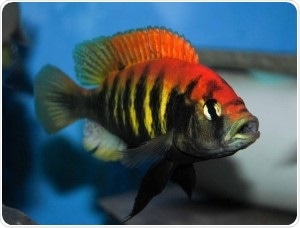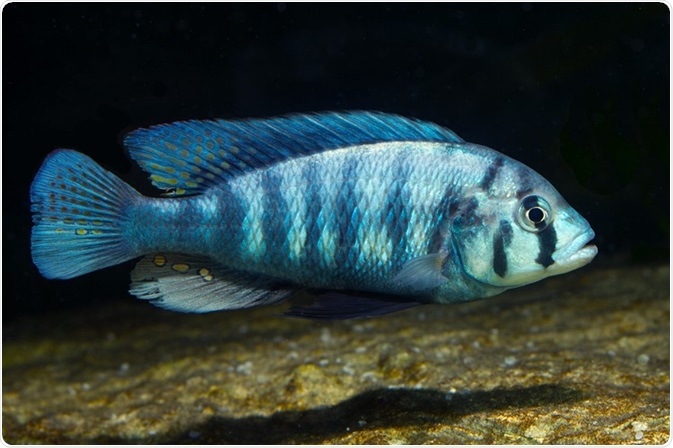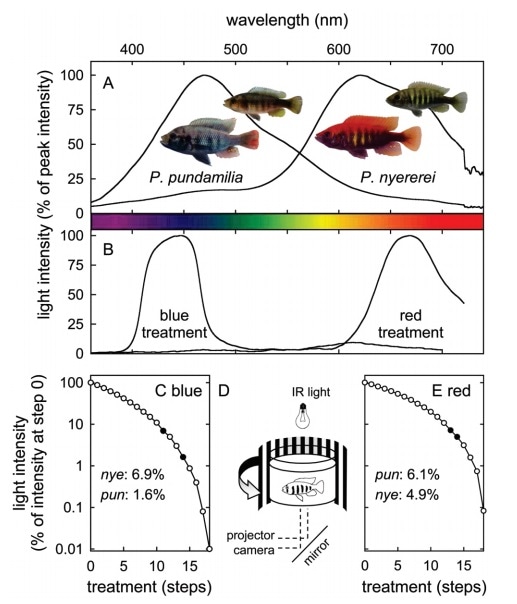Researchers from the field of natural sciences, find spectroscopy as an important investigatory tool. In fact, spectral analysis is extensively used by evolutionary researchers, geologists, climate scientists, and biologists as we make advances to understand the effects of energy and light.
At the University of Leiden, the Netherlands, researchers are using spectroscopy to investigate species differentiation of Cichlid fish populations near Makobe Island located in Lake Victoria, Tanzania. For this kind of study, researchers can only explore their subjects in their natural environment.
For potential researchers looking to widen their understanding of the natural world, robust and travel-ready spectroscopy tools will prove very useful. Avantes provides advanced spectroscopy instruments that can be used both on the field and laboratory.

Cichlid bio-diversity
The Cichlid species is a diverse and widespread variety of freshwater fish. The fish can be found across the Americas, the African continent, Southeast Asia, and parts of the Indian subcontinent. A member of the Cichlid family, Tilapia is a popular food-fish and so are the decorative Angelfish and Oscar, which are popular among aquarium enthusiasts.
To evolutionary researchers, the Cichlid species have particularly been a long-standing mystery. There are about 2,500 species of Cichlids estimated to be present around the world and among these, 500 species are found only in Lake Victoria, and nowhere else in the world.
The male Cichlid fish is known for having a rainbow appearance and its length varies from one inch to three feet, while the female fish have a plain color which makes them difficult to identify. These species are remarkably diverse and have emerged from just one variety dating back to 10,000 to 15,000 years ago. In terms of evolutionary time scale, the evolution of Cichlids is a strikingly recent event.
The Cichlid evolutionary puzzle
There is another reason for the evolutionary curiosity of the Cichlid species. Species differentiation often occurs due to geographic isolation which is known as allopatric speciation; however, the Cichlid species present in East African lakes differentiated without any physical restraints between populations.

The Cichlid populations have developed unique characteristics that have enabled most of them to find a distinctive niche within their environment. A single variety within a small area may evolve to prey on a single food source, while within the same area another variety may feed on another source.
For instance, the mouth of one Cichlid species opens on the left side and they feed on the scales on the right part of their prey, while the jaw of another species opens on the right side and they feed on the scales on the left part of their prey.
Researchers have long been puzzled with this strange mode of evolutionary differentiation. Sympatric (i.e. within the same geographic location) differentiation among the Cichlid species may be explained by sensory drive theory.
At the Institute of Biology of the University of Leiden, the Netherlands, researchers Matrine Maan, Kees Hofker, et al. examined two species of Cichlids — the Pundamilla nyererei and the Pundamilla pundamilla — that were found near the Makobe island, Lake Victoria close to the Tanzanian border.
To date, their study is the most convincing proof supporting the hypothesis of divergent sensory drive speciation. The term ‘divergent sensory drive speciation’ refers to the differentiation of two species that are closely related and driven by sensory perception differences between the populations.
One such pair of species are the P. nyererei and P. pundamilla Cichlids that developed divergent speciation and closely shared the habitat. During mating time, Cichlid females select the males for their bright coloration ands this fact has been well documented.
Based on this evolutionary process, scientists hypothesized that ecological factors that enable female selection of mates along a light gradient reveal the mechanism for quick sympatric speciation. This supports the theory of a divergent sensory drive speciation.
Environment and phenotype
In order to better understand these Cichlid species, their phenotype and environment should be understood first. The presence of particulates has made the Lake Victoria waters murky and turbulent.
Within this environment, short wavelength light (blue) is fully scattered and the spectra characteristics and light intensity change very quickly. The species P. nyererei and P. pundamilla share a habitat ranging between 0.5 M and 7 M in depth.
The spectra of these two micro-environments were first measured by researchers. The team calculated the orange ratios by utilizing the spectral intensity of the 550-700nm (orange red, yellow) range and dividing this by the spectral intensity of the 400-550nm (green, blue, violet) range.
For this kind of field spectra measurement in natural surroundings, the AvaTrek-ABF absorbance spectroscopy field kit equipped with dip probe attachment provides a suitable solution.

The primary habitat of the P. pundamilla species ranges from 0.5M to a depth of about 2M, where the short blue wavelength light is scattered. The male species are characterized by a bright blue color; 0.57 is the orange ratio in this area.
In contrast, the P. nyererei species were found to be more prevalent at 4-7M where the red shift is more marked. In the 4-7M range, the orange ratio was 0.75. A vivid red coloring is displayed by the males of this species. The two species are otherwise very similar, and between 2 M and 4 M, intermingle freely.
Optomotor response
Near the Makobe island, scientists caught live P. nyererei and P. pundamilla species. For better identification, the specimens were microchipped and placed in tanks, which were lit with high-frequency fluorescence (830 nm, 1,100 lux) to adjust to a typical 12-hour cycle of dark and light periods.
Following this acclimatization period, the female fish were placed in a round tank that was surrounded by a revolving screen of vertical black and white bars. The fish’s optokinetic response was then used to track a moving light to find out spectra sensitivity thresholds, which is the lowest intensity of light at which the fish reacted to the moving light stimulus. Using light filtered for red (656 nm) and blue (436 nm), the same test was repeated.
Both species showed a completely different response; the P. nyererei females showed a higher sensitivity threshold in red light, while the P. pundamilla females showed a lower sensitivity threshold in blue light.
Between the two tests and depending on visual response, 23 of 25 individual fish (92%) were defined into two non-overlapping groups. Since mate selection seems to rely on color display, the photo responsiveness of Cichlid females is a potential factor in the fast speciation seen in Cichlid biodiversity.
Spectroscopy in the field
Spectroscopy serves as a robust tool for scientists, as it allows fast and non-destructive analysis and also provides information on many areas of scientific investigations. Rugged designs together with modular equipment have now made it relatively easy to apply spectra analysis for absorbance, irradiance, fluorescence, and reflectance in the field.
Customers can contact Avantes sales engineers to learn more about the latest AvaTrek field spectrometer kits that are distributed only in North America.
References and Further Reading
About Avantes BV
 Avantes is a leading innovator in the development and application of miniatures spectrometers. Avantes continues to develop and introduce new instruments for fiber optic spectroscopy to meet our customer’s application needs.
Avantes is a leading innovator in the development and application of miniatures spectrometers. Avantes continues to develop and introduce new instruments for fiber optic spectroscopy to meet our customer’s application needs.
Avantes instruments and accessories are also deployed into a variety of OEM applications in a variety of industries in markets throughout the world.
With more than 18 years of experience in fiber optic spectroscopy and thousands of instruments in the field, Avantes is eager to help our customers find their Solutions in Spectroscopy®.
Techniques Supported
- UV-VIS/NIR spectroscopy
- Process control
- Absorbance/transmittance/reflectance
- Laser-induced breakdown spectroscopy
- CIE color spectroscopy
- Portable spectrometers
- Fluorescence spectroscopy
- Custom applications
- lrradiance
- Raman spectroscopy
- OEM application development
Major Products/Services
Low-cost. high-resolution, miniature fiber optic spectrometers: System solutions and OEM instruments for applications from 185 nm to 2500 nm. Detector choices: PDA, CMOS, CCD, back-thinned CCD, and lnGaAs.
Optical benches with focal lengths of 45, SO or 75 mm; revolutionary new ultra-low straylight
optimized optical bench (ULS) and a new high sensitivity optical bench.
Other Features
- 14 and 16 bit AID converters
- TE cooling
- multi-channel instrument configurations enabling simultaneous signal acquisition
- USB2 communication
- support for multiple instruments from a single computer
- 14 programmable digital I/O ports
Standard Application Solutions
- lrradiance and LED measurements
- gemology
- hemometric analysis
- thin-film measurement
- color
- fluorescence
- laser-induced breakdown spectroscopy (LIBS)
- Raman spectroscopy
- process control
Light Sources
- Tungsten-halogen
- Deuterium
- LED
- Xenon calibration sources for wavelength and irradiance
Sponsored Content Policy: News-Medical.net publishes articles and related content that may be derived from sources where we have existing commercial relationships, provided such content adds value to the core editorial ethos of News-Medical.Net which is to educate and inform site visitors interested in medical research, science, medical devices and treatments.